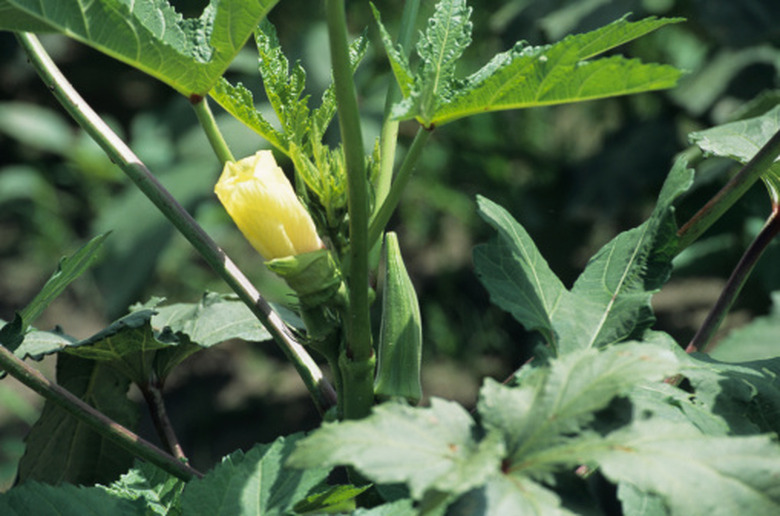Why Are My Okra Plants Yellow?
Okra plants turning yellow signal potentially disastrous problems. Yellowed leaves lack chlorophyll, the catalyst that converts sunlight to food for the plant. As the plant starves, okra's natural resistance to insects and disease declines. Yellowed leaves sometimes indicate problems gardeners can easily remedy, but other issues require long-term solutions, such as crop rotation and soil improvement.
Poor Soil
Planting okra seed in soil colder than 65 degrees Fahrenheit could cause immediate root problems. Waiting to plant until about 10 days after the last frost date gives soil time to warm enough for okra. Mounding the planting row also raises the soil temperature. Lack of nitrogen could also cause yellowing problems in okra, which needs rich well-drained soil for proper growth. Increasing the amount of organic material in the ground improves drainage and reduces okra problems in heavy clay. Cultivate the ground deeply before planting, turning over the top 8 to 10 inches of soil.
Fungal Infection
Dense clay soils with poor drainage provide favorable conditions for fungal disease in okra. Okra shows no resistance to verticillium wilt, which damages okra roots and causes wilting and yellowing of the plant above ground. Lower leaves show symptoms first, and problems move higher on the plant as the disease spreads. Leaves shrivel and die in the final stages of the infection. No chemical treatment will help okra infected with verticillium wilt. Fungal spores overwinter in soil, setting the stage for more problems. Solarization by heating the upper layers of soil under clear plastic sheeting reduces the incidence of verticillium wilt.
Insect Problems
Sucking insects could attack okra, and cause loss of vigor and dying leaves. Red spider mites suck the plant's sap from leaf surfaces, causing a speckled, white or yellow pattern on leaves. In heavy infestations, leaves turn pale and then shrivel and brown. Aphids also drain the plant of nourishment by sucking fluid from leaves and stems. Both adult tobacco whiteflies and whitefly nymphs feed on okra sap and could cause plants to wilt and yellow. Checking the undersides of leaves and the stems of okra plants should reveal any insect problems. Spraying the plants with insecticidal soap destroys soft-bodied pests.
Nematodes
Nematodes could cause serious damage to okra as the small roundworms bore into roots. When the plant's wound heals, galls or root-knots form. Severely affected okra plants lose the ability to draw up water and nutrition from the soil. The upper plant yellows and dies. No chemical treatments are approved for nematode problems in the home garden, according to the University of Florida Extension. Gardeners can control nematodes through crop rotation, planting okra after crops such as corn, brassicas or onions. Cover cropping with marigolds and turning the plants under reduces nematode numbers. Improving soil quality by adding humus and repeatedly tilling the ground also prepares a healthier plot for okra.
References
- Texas AMU Extension; Growing Okra for South & Central Texas Homeowners; David Rodriguez
- University of Illinois Extension: Okra
- Alabama Cooperative Extension; Fusarium and Verticillium Wilt; Edward J. Sikora; November 2004
- Infonet-Biovision: Okra
- University of Florida Extension; Control 'Root-Knot Nematodes' in the Garden; Dan Culbert; August 2008
